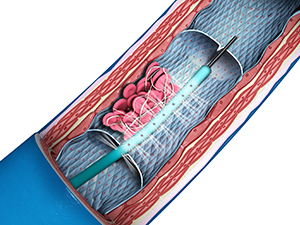Thrombolytic Therapy
 The normal process of blood clotting or coagulation occurs when platelets clump with other blood components to form a gel. Generally, clotting after an injury avoids excessive bleeding, but clots formed in the blood vessels of the body may block the blood flow in vital organs such as the lungs, heart or brain creating a life threatening situation which requires emergency management.
The normal process of blood clotting or coagulation occurs when platelets clump with other blood components to form a gel. Generally, clotting after an injury avoids excessive bleeding, but clots formed in the blood vessels of the body may block the blood flow in vital organs such as the lungs, heart or brain creating a life threatening situation which requires emergency management.
Thrombolytic therapy breaks up fatal blood clots in the blood vessels by administering either clot-dissolving medications or inserting a catheter through the blood vessels to mechanically break the clot.
Indications
Thrombolytic therapy is most commonly indicated to treat a blood clot in the blood vessels of your brain such as in ischemic stroke. Other indications for therapy include:
- Pulmonary embolism (clot in the lung artery)
- Deep vein thrombosis (clot in the deep veins of legs)
- Clot in the heart (heart attack)
- Clot in the arteries of arms or legs
- Blocked dialysis access catheter or bypass graft
Pre-procedural Preparation
Before thrombolytic therapy is undertaken, your doctor will order tests to confirm that you are a candidate to receive the therapy. You may be asked to stop medications that increase the risk of bleeding and other complications. You will have to undergo angiography with a contrast agent so that the internal structure of your blood vessels and location of the clot can be viewed before the therapy.
Procedure
Thrombolytic therapy can be delivered by inserting a catheter in the vein and guiding it towards the clot. Your doctor will first clean and shave the site of catheter insertion on the skin and numb the skin with local anaesthetic agent. A small incision or puncture is made in the skin and the catheter is inserted along with the contrast agent to track the blood vessels. X-rays will be taken to locate the clot in the blood vessels. Thrombolytic medications will be injected through the catheter near the location of clot to break or dissolve the clot. Your doctor will monitor the breaking of the clot with help from X-ray images. The procedure can vary from several hours to even days before the clot is fully dissolved. Once the clots have dissolved, your doctor will check for satisfactory range of the blood’s ability to coagulate and remove the catheter. The site of puncture will be compressed for 20 minutes to stop bleeding.
Sometimes, your doctor may perform a mechanical procedure to treat the clots. Small devices such as a suction cup, fluid jet, rotating device or ultrasound device is placed on the end of the catheter tip to physically break the clot.
Post-procedural care
Following the procedure, you will have to rest for several hours to prevent bleeding from the punctured site. Inform your doctor if you experience fever, pain, or swelling and discolouration of the limb. You may be prescribed medicines, diet or physical therapy after an emergency thrombolytic therapy.
Risks & Complications
As with any procedure, thrombolytic therapy involves certain risks and complications. They include:
- Bleeding at the puncture site
- Low blood pressure
- Rarely, bleeding in the brain







